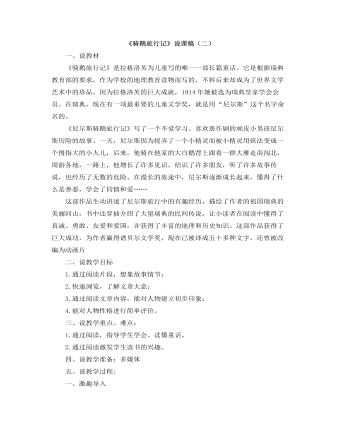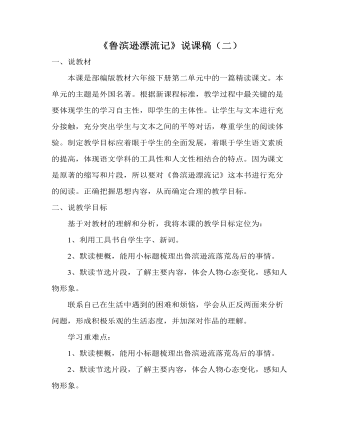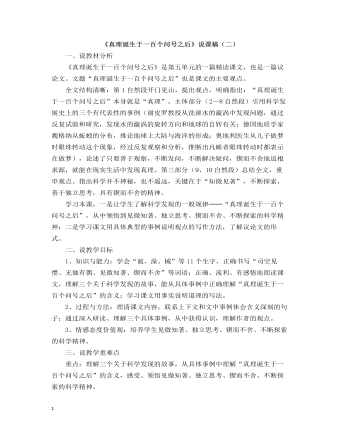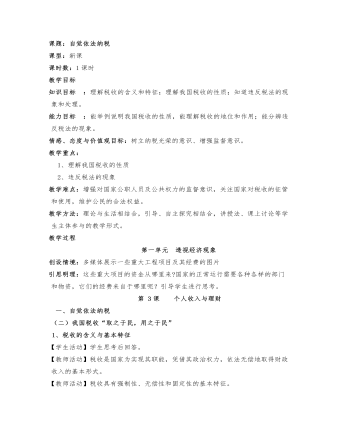-

人教版新目标初中英语八年级下册He said I was hard-working教案2篇
This activity introduces some new vocabulary and provide oral practice using the target language.Task 1 . Ask four students to stand in front of the class, and the teacher asks them the following questions as a reporter.1.What are you going to do when you grow up?2.What are you going to do next week?3.What are going to do after school?The students will give different answers, then ask a good student to report what they said.I am going to e a doctor.What did she say?----------She said she was going to be a doctor.I am going to have a party on Friday night.What did he say?-------He said he was going to have a party on Friday night.I am going to do my homework.What did she say ?------ She said she was going to do her homework.I am going home after school.What did she say?-----She said she was going home after school.Say In this unit we are going to learn to use words like to report what someone said.Task 2. Read the instructions. Then ask a student to read the four questions. And write the words on the Bb. Explain what soap opera is.Task 3. Ask the students to Look at the pictures, point out the TV screens in the picture. Ask one girl to read what Marcia said.What did Marcia say? She said She said she was having a surprise party for Lana on Friday night. Repeat the other pictures in the same way.Activity3. Listen and number the pictures in activity 1a.

人教版新目标初中英语八年级下册What were you doing when the UFO arrived教案2篇
(一).知识方面: 1.培养学生能运用过去进行时来描述、谈论过去某个时间正在发生的事情或动作的意识和能力,能就过去某个时间正在发生的动作做出正确的描述。 2.培养学生的想象力和角色扮演的合作能力。 3.培养学生讲述过去发生的事情经过的能力。能正确运用一般过去时来讲述故事。 (二).技能方面: 1.本单元的语言目标是Talk about past events and tell a story(谈论过去的时间和讲述一个故事),围绕这一目标,要涉及句型: What were you doing when the UFO arrived? ----I was sitting in the barber’s chair. The barber was cutting my hair. 因此必须学习standing、studying、cleaning、sleeping、cooking、making、eating、cutting、等表示地点的词,以便为上述句型提供语言材料。2.学习过去进行时的有关知识。Was/were+现在分词,是该时态的表达式。 3.在学习过程中,要区分The boy was walking down the street when the UFO landed.和While the boy was walking down the street, the UFO landed.这两种由when和while引导的状语从句的句型结构。注意它们的不同。

人教版新目标初中英语八年级下册Why don’t you get her a scarf教案
教师带领学生复习有关描述宠物的词汇,采用教师提问学生回答的方进行。如:T:What animals do you think would be good pets?What animals do you think would be bad pets?What do you think are good animals for a six-year-old child?然后学生进行 pairwork 练习。Task two: 师生互动,学习探究 1、播放3a部分的录音,引导学生一边听录音,一边跟读。2、通过听录音学生回答以下问题:Why do you think pot-bellied pigs are popular?What are the advantages and disadvantages of keeping such a pet?教师对学生的回答进行及时点评。3.学习范文,学习重点短语,为下步的模仿写作提供语言素材。T :1. )Have you ever kept a pig as a pet?Do you like pigs? St.:No.…Why don’t you like to keep a pig? St: No.They’re too dirty and lazy(Do you know in some foreign countries like Hollyland, Australia,pigs are the most popular pet.there’s a kind of pig.(图)it has an interesting name? it ‘s called a pot-bellied pig.) Now,let’s learn an article about this kind of interesting pet.2.)play the tapeSt.:Listen and repeat3.)show some Qs on computer(本子St.: read silently,then answerthe Qs(本子)4.)Ask ss. Close book and retell this passage.(what is a pot-bellied pig? Is it a good or bad pet? ) St.: retell it to each other“A pot –bellied pig is a popular pet now…”5.read the article together.St.:.practice reading

人教版新目标初中英语八年级下册Would you mind turning down the music教案
Step 4. Group work (4)1. Ask a pair of students to read the dialogue. Say, This activity provides speaking, listening and writing practice using the target language.2. Ask students to complete the work in groups.3. Check the answers with the whole class. 4. Explain some of the language points. Step 5. Word review (Self check 1)1. Ask students to read the words and the phrases given. 2. Fill in the blanks with proper forms of these words to complete the sentences. 3. Check the answers with the whole class. Homework:Do activity 2 on page 57 after class. Period 6Teaching aims: 1. Teach vocabulary words and the useful expressions. 2. Enable the students to learn etiquette in different culture. 3. Help the students learn how to behave politely in public places and in daily life. Teaching procedures:Step 1. RevisionHelp students to review the function of making requests through a free talk. Then lead them to the topic of etiquette. Explain the meaning of etiquette. Or, ask students to look it up in the dictionary. Step 2. Pre-reading (Section 1)1. Ask students to read the picture and make a list with their partner about how many rules of etiquette can be seen being broken.

人教版新目标初中英语七年级下册How was your weekend教案2篇
Teaching Goal:1. General aims:Talk about recent past events2. Particular aims:A. Language Focus.Talk about recent past events and think of the past events.B. Language goalsHow was….?It was …What did …do over the weekend?C. Language structures:(1). How was your weekend? I was great. Pay attention to no form.(2). What did you do over the weekend? I played soccer. We went to the beach.D. Useful words and phrases:Words: was, did, went, beach, over, project, test, wasn’t, false, number, geography, spend, week, most, mixture, their, had, little, cook, read, saw, change, everyone, sit, sat, no, anythingPhrases: did one’s homework, played soccer, cleaned my room, went to the beach, played tennis, went to the movies, on Saturday morning, over the weekend, cook … for, what about, do some reading, have a party, talk show, go shoppingE. Grammar language:Present simple past tenseRegular and irregular verbsF. Learning strategies:Tour and holidaysG. Interdiscipinary:H. Emotion and manner:Teaching time: 5 periodsTeaching procedures:Period One教学步骤、时间 教师活动 学生活动 媒体应用Step 1Free talk 3’ Ask some questions like:Who’s on duty today?What’s the weather like? Answer and talk about something.让同学们回答下列问题1. Do you like weekend? (Let some students answer)It takes them three minutes to talk about the question.2. Why do you like weekend? (let the students answer) Most of the students like the weekend此时教师用汉语问:“在周末期间问你干了什么?这句话用英语这么回答?Let the students guess.At last the teacher give them right answer3. What did you do over the weekend?(板书、学习)

人教版新目标初中英语七年级下册I ’d like some noodles教案
教学过程Step 1: warming-up Sing a song---------“food and drink” Step 2: Revision1 Dictation2 Revise: What kind of noodles would you like?I’d like …What size bowl of noodles would you like?I’d like…Step 3: Presentation1 show pictures of food, ask students say the words.2 Students read the newspaper ad in 3a. Fill in blanks with words in the box. Then read the ad together, the teacher explains some difficult language points.3 Check the answers Step 4 PracticeAsk students to finish 3b in the same way according to 3a. Students read the short passage and fill in the blanks .At last, check the answers.Step 5 productionAsk students to write their own ad for dumplings, noodles, drinks, and other foods they know. Then ask students to read their partner’s ad. Then order food and drink from their partner.Step 6 Home workGroup work – make an ad about “food and drink”

人教版新目标初中英语七年级下册I want to be an actor教案2篇
三、教学建议第一课时:1. Lead in (Vocabulary)A) Before class, teacher should collect some pictures of working places. For example: Bank, TV Station, Restaurant, Police Station, Hospital ...B) In class, show students the pictures (PowerPoint, OHP). Ask students to tell the name of the working places and the name of the jobs.Shop assistant, doctor, actor, reporter, police office, waiter, bank clerk, studentC) Do exercise 1a and 3a.2. Bingo GameAsk groups of students to make up pairs of cards with a job on one and the related workplace on the other. For example, waiter / restaurant, teacher / school, doctor / hospital. Encourage students to use both the job / workplace combinations in the book and the ones that students came up during class discussions. Be sure they have twice as many sets of cards as there are students in the group. They can make two sets of cards for a single job / workplace, if necessary. Then have each group mix up its set of cards and hand their cards out in random order. Each time a student gets a pair of cards that match, he or she can lay these cards down. The goal is to have no cards in your hand at the end.3. Task OneA) Ask students to work in pairs and ask the partner what does he / she want to be in the future.e. g. :What do you / does he / does she want to be?I want to be a.Why?Because it's (adj).B) Vocabulary: Section B, 1a4. Homework 1.2.

人教版新目标初中英语七年级下册Where did you go on vacation教案
句型: Where did you go on vacation? I went to summer camp.Did she go to Central Park?Yes,she did.No, she didn’t语法:一般过去时特殊疑问句、一般疑问句及肯、否定回答。课时安排4课时第一课时:Section A:la,1b,lc,2a,2b,2c 第二课时:Section A:3a,3b,4第三课时:Section B:1,2a,2b,2c第四课时:Section B:3a,3b,3c,4 and Self Check第一课时教学目标掌握描写假期生活的形容词。假期里自己所做事情的简单表达。谈论假期做的事情及当时情况。谈论假期时旅游的天气,旅游者以及食物等。教学过程一、导入播放一首英文歌曲:Let’s travel 说明:通过让学生听节奏欢快迪斯尼英语歌曲Let’s travel.引入本节课谈论的话题vacation and travel. 让歌曲使学生的思维活跃,增强课堂气氛,激发学生提高学习英语的兴趣。T:How is the trip ?Ss : It’s pretty good/ happy/exciting /relaxing/busy/dangerous/ fantastic说明:这个问题是为了操练形容词。建议让多个Ss作答。鼓励他们用不同的形容词。上述个别形容词本应在第二课时中出现,但可以在warming-up中第一次非正式出现。这些形容词也可在老师的评价语中适时出现,以加深学生对词汇的印象。

人教版新目标初中英语七年级下册Why do you like koalas教案2篇
单元整体说明(一)单元教材分析本单元的核心话题是描述动物和表达个人喜好,以及句式why do you like…? Because…。这也是本单元的教学重点。通过本单元的学习,学生应能较流利地运用所学词汇和句型描述动物,表达个人喜好。(二)单元知识结构1.词汇动物名称 tiger, elephant, koala, dolphin, etc.词汇描述性形容词: smart, cute, ugly, clever, shy, etc.国家名: Australia, South Africa2.句型Why do you like koala hears? Because they are cute.Where are pandas from? They're from China.What animals do you like? I like dolphins.(三)单元整体目标1.Master the vocabulary2.Master and use: Why do you like koalas? Because they am cute.Where are pandas from? They're from China.What animals do you like? I like dolphins.(四)单元教学重难点一览(五)单元学情分析学生此前已经学过由why, where, what 引导的特殊疑问句句型,具有了学习本单元知识的认知前提。形形色色的动物能激发学生的好奇心,产生了解它们的欲望,这有利于本单元知识的教学和学生学习兴趣的培养。

人教版新目标初中英语八年级下册Have you ever been to an amusement park教案
(1)Have you ever been to …? Yes, I have. / Yes, I have ever been to …No, I haven’t. / No, I have never been to …(2)When did you go there? I went there last year. (3)I have never been to a water park. Neither have I. I have ever been to an amusement park. So have I. (4)How long have you been studying English? I’ve been studying English since nine o’clock. I’ve been studying English since I came back home. I’ve been studying English for five hours. (5)What’s that? It’s an amusement park in Japan. I’ve never been to an amusement park like it before. It’s fun to learn another language. Let’s go tonight. Isn’t this great?space museum, amusement park, water park, South America, Peru, Holland, European culture, tour guide, flight attendant, musical instrument, more than, be from, get to, take lessons, neither, discover, graduate, change

人教版新目标初中英语八年级下册What should I do教案2篇
说明:在帮Li Lei提建议的同时,教育学生如何学好英语。第三课时教学目标1. 语言目标:a) 词汇: Original, in style, haircut, the same as.b) 语言结构:My friend wears the same clothes and has the same haircut as I do.2. 能力目标:大多数学生能够谈论自己喜欢哪种服装,提高查找信息的能力。3. 情感目标:学会如何与朋友相处,要有自己对时尚的看法。教学重点掌握一些重要词汇。教学难点学会谈论问题,并能提出书面建议。◆教学突破首先针对Erin的问题,提出个人的建议,模仿2c部分的对话展开双人交际Pair-work;听老师诵读3a部分的信件,并找出LEFT OUT的问题所在;学生完成3b部分的内容,给Left Out提出书面的建议;学以口头形式提出自己目前存在的某个问题,讲给大家听,让同学们给自己提出一个建议,并作笔录;学生两、三个人分成一组,随意性地进行口语交际,谈论P14的第4部分的某个问题,相互交换意见。

人教版新目标初中英语八年级下册It’s a nice day, isn’t it教案2篇
"Hello! Welcome to English class! Introduce yourself. Meet your new classmates." That's what the teacher says. What do you say? "Oh no!" It can be difficult talking to new people. But it can be fun, and you can make friends. How do you do it? Make small talk. Small talk is polite conversation. "Wang Nan is a great pingpang player, isn't she?" "I'd love to meet her, wouldn't you?" "It's been raining a lot, hasn't it?" Tag questions are a form of polite speech. To make small talk successfully, you should know how to make them. You should also know what topics to talk about. Try to learn this unit carefully. The next time you're in English class, you'll find out. Making small talk's easy, isn't it? (“你好!欢迎你!请做一下自我介绍。认识一下你的新同学。”通常在课上老师会这样说。你会说什么呢?“噢,不!”与陌生人谈话太困难了。但是这也很有意思,并且你还能交到朋友。你该怎么做呢?闲聊。闲聊指得是礼貌的对话。“王楠是一个很棒的乒乓球运动员,不是吗?”“我希望自己能认识她,你呢?“今年的雨水很多,不是吗?”反意疑问句是一种礼貌用语。为了使得谈话成功,你应该知道怎样去进行闲聊。你还应该知道与不同的人该谈论什么样的话题。认真的学习这个单元吧,下次在英语课上,你会发现与大家展开谈话是一件很容易的事情,不信我们来试试。)

人教版新目标初中英语八年级下册How long have you been collecting shells教案2篇
Step Ⅱ Show the new words on the screen and teach the new words. Read the new words to students and ask them to repeat.Step Ⅲ 3aThis activity introduces new vocabulary and provides reading practice using the target language.In this activity first look at the four pictures.T: What can you see in the pictures?Ss: Four snow globes.T: Right. There are four snow globes in the pictures. And what are they?Ss: They are a monster, two polar bears, two penguins and a birthday cake.Write these words on the blackboard: snow globe; monster; polar bear; penguin and birthday cake. Read them to the class and ask students to repeat each one. Make sure students understand each word.Use a computer to show the E-mail message on the screen and read the message to students.Get students to read the e-mail on their own, and then draw lines connecting each snow globe and its description.Correct the answers.AnswersA line should connect each snow globe picture with the words that describe it in the letter.Step Ⅳ 3bThis activity provides writing practice using the target language.First review Activity 2a on Page 47.Then ask students to complete the message according to Activity 2a.Some partial sentences are given to students. Write about one person's collection.When students work, walk around the room checking the progress and offering help as needed.When they finish, ask some students to read their messages to the class.

部编人教版六年级下册《骑鹅旅行记(节选)》说课稿(二)
一、说教材《骑鹅旅行记》是拉格洛芙为儿童写的唯一一部长篇童话。它是根据瑞典教育部的要求,作为学校的地理教育读物而写的,不料后来却成为了世界文学艺术中的珍品。因为拉格洛芙的巨大成就,1914年她被选为瑞典皇家学会会员。在瑞典,现在有一项最重要的儿童文学奖,就是用“尼尔斯”这个名字命名的。《尼尔斯骑鹅旅行记》写了一个不爱学习、喜欢恶作剧的顽皮小男孩尼尔斯历险的故事。一天,尼尔斯因为捉弄了一个小精灵而被小精灵用妖法变成一个拇指大的小人儿,后来,他骑在他家的大白鹅背上跟着一群大雁走南闯北,周游各地,一路上,他增长了许多见识,结识了许多朋友,听了许多故事传说,也经历了无数的危险。在漫长的旅途中,尼尔斯逐渐成长起来,懂得了什么是善恶,学会了同情和爱……

部编人教版四年级下册《 “诺曼底号”遇难记》精彩片段(二)说课稿
师:对,镇定自若。(板书:镇定自若)这份镇定自若,别人能与他相提并论吗?(不能)4.你还能从这段话中读出什么来?妇女先走,船员断后。咱们常说女士优先,在灾难面前也做到让妇女先走,这叫什么?生:绅士风度。(板书:绅士风度)5.同学们,假如你就是哈尔威船长,面对混乱的人群,你准备怎样来下达这道命令?指名学生朗读。(师指导:场面混乱,情况危急。)师:在灾难面前,时间就是生命。师:这是庄严的指挥,这是威严的指挥。我们一起来读读。师:真好,读得好,脸部的表情也非常到位,满脸的威严,正因为这样,所以课文的作者雨果是这样评价船长的,再读。ppt:在英伦海峡上,没有任何一个海员能与他相提并论。(生齐读)师:不能与他相提并论的还有他的:忠于职守、镇定自若、绅士风度。这是咱们从第一幅画面中感受到的。

部编人教版六年级下册《汤姆·索亚历险记(节选)》说课稿(二)
一、说教材 《汤姆·索亚历险记》由“找到汤姆和贝琪”这个精彩片断组成。片段讲述的是汤姆和贝琪从迷路的山洞返回家后的故事。先是讲述贝琪的妈妈撒切尔太太和汤姆的姨妈悲痛绝望的心情,以及汤姆、贝琪回来后小镇欢乐的晚上。先悲后喜,充满了喜剧气氛。接着通过汤姆的讲述,介绍他和贝琪在洞中的历险经过,最后讲汤姆去看望伙伴哈克和贝琪,从法官口中意外地知道山洞已被封上,乔埃被困洞中。轻松、幽默而略有讽刺夸张,是作者语言的特点。浪漫有趣,有惊无险,是这部名著吸引孩子的地方。 选编本文的目的,一是通过对课文的阅读,了解这部外国名著的内容,关注人物的命运,把握人物的性格;二是激发学生读整本书的兴趣。 本文的教学重点是通过阅读精彩片段,把握名著的内容,激发学生读外国文学作品的兴趣。

部编人教版六年级下册《鲁滨逊漂流记(节选)》说课稿(二)
四、说学法学生是学习的主体。皮亚杰认为,在教学过程中,儿童如果不具有自己的意象活动教育就不能成功。1、整体感知,初步了解课文的大概内容。学生先自读课文。自学完以后,概括出文章的主要内容。这样,学生就会从整体上知道这篇课文讲的是什么内容。2、充分自学。人的大脑接受信息,有意注意总比无意注意有效得多。本课内容浅显易懂,可以充分放手让学生自学,经过自学,学生对课文有了一个大概了解,有了一番摸索的功夫,或者是略有解悟,或者是不得要领,或者是困惑不解。一旦进入探讨阶段就会全身心投入。一方面可以从容、有条不紊地发表自己的见解;另一方面略有所悟的急需得以印证和深化,不得要领的急需理清头绪,困惑不解的急需弄个明白,自然都格外注意,毫不懈怠。这样既提高了学习兴趣,又留下了深刻印象,还强化了自主意识。

部编人教版六年级下册《真理诞生于一百个问号之后》说课稿(二)
一、说教材分析《真理诞生于一百个问号之后》是第五单元的一篇精读课文,也是一篇议论文。文题“真理诞生于一百个问号之后”也是课文的主要观点。全文结构清晰:第1自然段开门见山,提出观点,明确指出:“真理诞生于一百个问号之后”本身就是“真理”。主体部分(2—8自然段)引用科学发展史上的三个有代表性的事例(谢皮罗教授从洗澡水的漩涡中发现问题,通过反复试验和研究,发现水的漩涡的旋转方向和地球的自转有关;德国地质学家魏格纳从蚯蚓的分布,推论地球上大陆与海洋的形成;奥地利医生从儿子做梦时眼珠转动这个现象,经过反复观察和分析,推断出凡睡者眼珠转动时都表示在做梦),论述了只要善于观察,不断发问,不断解决疑问,锲而不舍地追根求源,就能在现实生活中发现真理。第三部分(9、10自然段)总结全文,重申观点。指出科学并不神秘,也不遥远,关键在于“知微见著”,不断探索,善于独立思考,具有锲而不舍的精神。

北师大初中八年级数学下册分式的乘除法教案
通常购买同一品种的西瓜时,西瓜的质量越大,花费的钱越多,因此人们希望西瓜瓤占整个西瓜的比例越大越好.假如我们把西瓜都看成球形,并把西瓜瓤的密度看成是均匀的,西瓜的皮厚都是d,已知球的体积公式为V=43πR3(其中R为球的半径),求:(1)西瓜瓤与整个西瓜的体积各是多少?(2)西瓜瓤与整个西瓜的体积比是多少?(3)买大西瓜合算还是买小西瓜合算?解析:(1)根据体积公式求出即可;(2)根据(1)中的结果得出即可;(3)求出两体积的比即可.解:(1)西瓜瓤的体积是43π(R-d)3,整个西瓜的体积是43πR3;(2)西瓜瓤与整个西瓜的体积比是43π(R-d)343πR3=(R-d)3R3;(3)由(2)知,西瓜瓤与整个西瓜的体积比是(R-d)3R3<1,故买大西瓜比买小西瓜合算.方法总结:本题能够根据球的体积,得到两个物体的体积比即为它们的半径的立方比是解此题的关键.

八年级思想政治下册自觉依法纳税教案
一、自觉依法纳税(二)我国税收“取之于民,用之于民” 1、税收的含义与基本特征 【学生活动】学生思考后回答。 【教师活动】税收是国家为实现其职能,凭借其政治权力,依法无偿地取得财政收入的基本形式。 【教师活动】税收具有强制性、无偿性和固定性的基本特征。[1]强制性:不管你愿意还是不愿意,都必须交税。[2]无偿性:交了税,没有补偿,更不会返还。[3]固定性:征税是有标准的,不是无止境的,按标准收到一定数量即算完成纳税。 2、税收的性质 【教师活动】展示多媒体图片,观察税收性质是什么? 【学生活动】分析图片,税收的性质。 【教师活动】每个人都与税收紧密地联系在一起,我们天天享受到的公共物品,无不有赖于税收。接受教育要有学校,看病要有医院,出行要有道路,保障国家安全要有国防,防洪、发电要有水利工程,这些都要依靠国家的税收来为公众提供公共服务。 【教师活动】播放国家免费为新冠肺炎患者治疗的视频。 【教师活动】劳动人民是税收的最终受益者,我国的税收是取之于民、用之于民的新型税收。